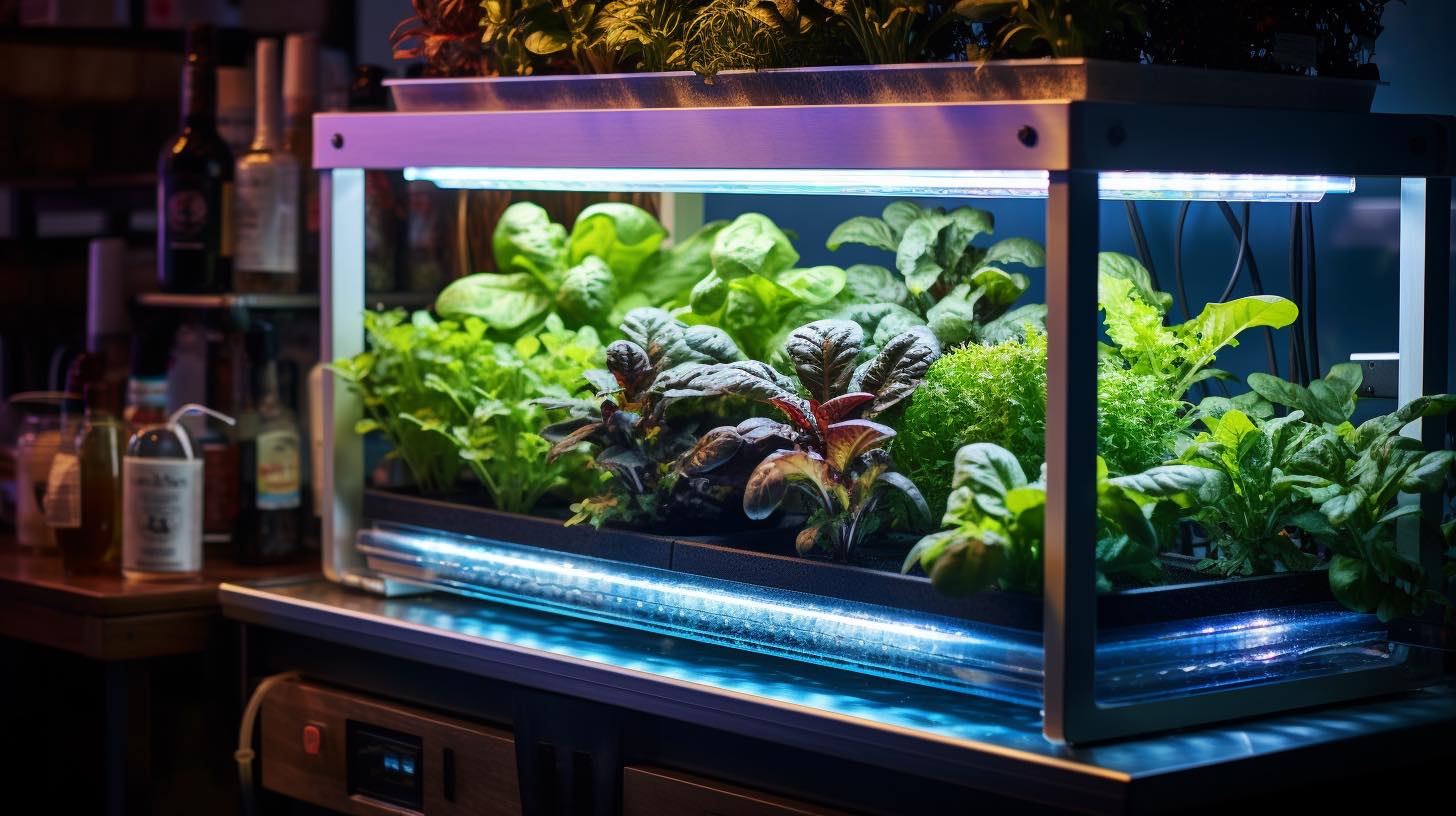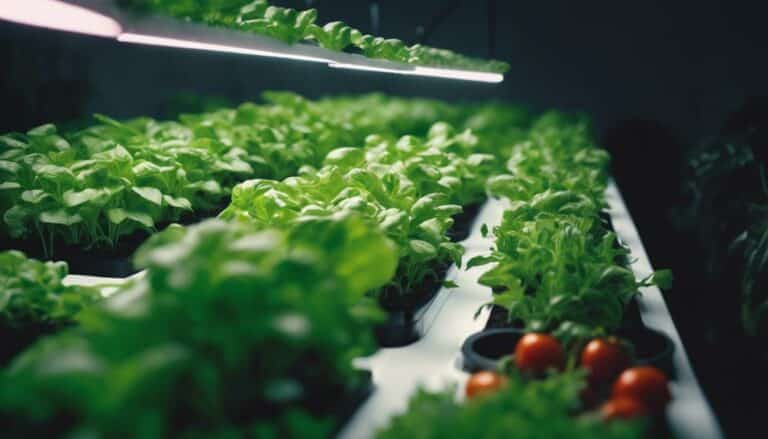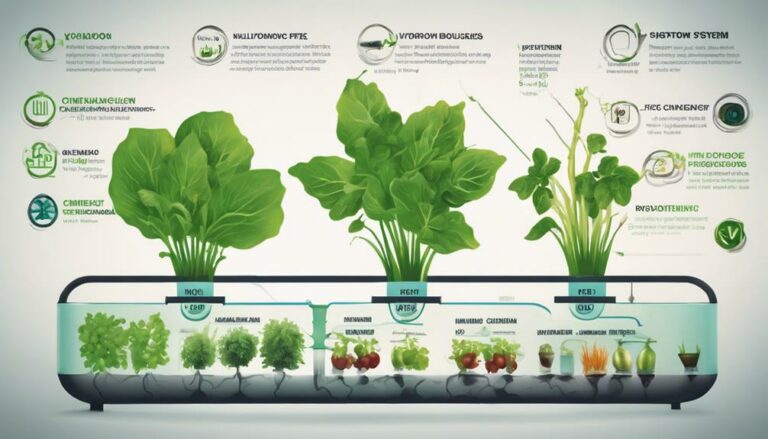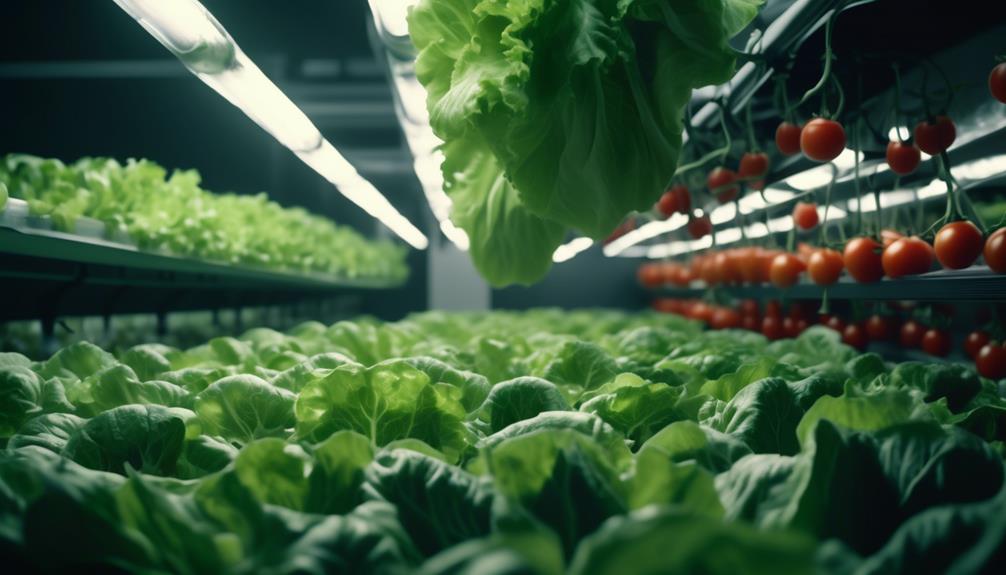Achieving a successful vegetative stage in hydroponics requires attention to certain key factors. Let me share with you the practices that have proven to make a difference.
From controlling light intensity and quality to maintaining the right nutrient balance, these factors play a crucial role.
In this article, I will guide you through essential practices like temperature regulation, air circulation, pH control, CO2 supplementation, pruning, and pest prevention.
Table of Contents
By following these practices, you will be well-equipped to thrive in your hydroponic journey.
Key Takeaways
- Maintaining the right balance of light intensity and quality is crucial for a successful vegetative stage in hydroponics. LED lights are a preferred option due to their energy efficiency and customizable light spectrums.
- Achieving a proper nutrient balance is essential for healthy vegetative growth in hydroponics. This includes maintaining optimal nutrient ratios, maximizing nutrient uptake efficiency, and preventing nutrient deficiencies through regular monitoring and supplementation.
- Maintaining the right temperature, humidity, and air circulation is important for the optimal growth of plants during the vegetative stage in hydroponics. Controlling these factors ensures that plants have the ideal environment for photosynthesis, nutrient absorption, and overall health.
- Implementing pruning and training techniques, monitoring pH levels, supplementing CO2, and practicing disease and pest prevention are key strategies for promoting robust vegetative growth and preventing issues in hydroponics. Regular monitoring, proactive measures, and biological control methods can help maintain a healthy and productive hydroponic system.
“Maintaining the right balance of light intensity, nutrient ratios, temperature, and humidity is crucial for achieving healthy and robust vegetative growth in hydroponics.”
Light Intensity and Quality
Light intensity and quality are crucial for a successful vegetative stage in hydroponics. Two popular options for hydroponic lights are LED lights and HPS lights. LED lights offer several advantages over HPS lights. They are more energy-efficient, generate less heat, and can be customized to provide specific light spectrums. This customization is important for promoting healthy plant growth during the vegetative stage. By adjusting the light spectrum, you can ensure that your plants receive the right amount and type of light for photosynthesis. Additionally, LED lights have a longer lifespan, reducing the frequency of replacements. Investing in LED lights for your hydroponic system can lead to improved plant growth and higher yields.
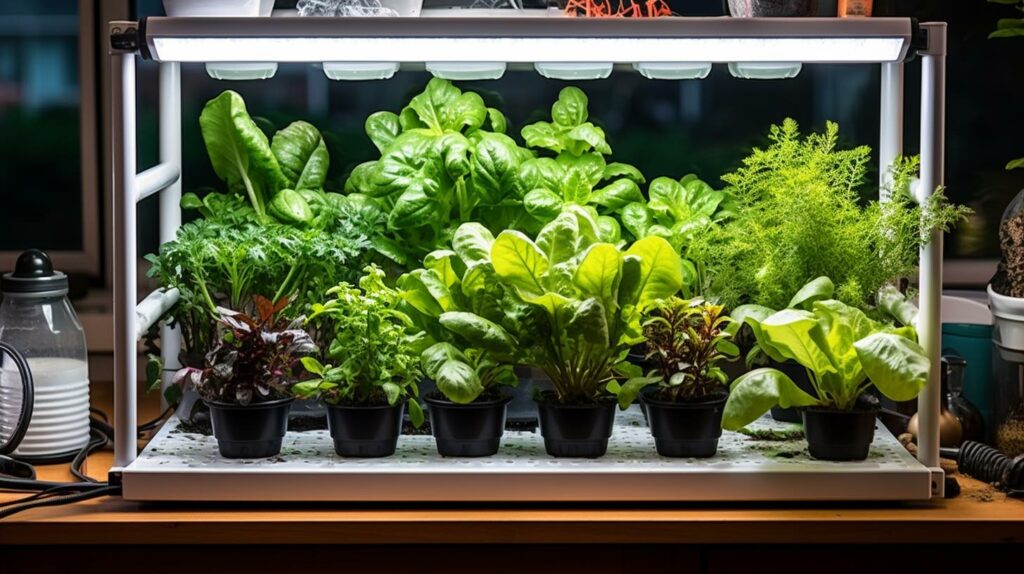
Nutrient Balance
Achieving a successful vegetative stage in hydroponics requires maintaining a proper nutrient balance. There are three key considerations: optimal nutrient ratios, nutrient uptake efficiency, and avoiding nutrient deficiencies.
It’s important to find the right balance of essential nutrients like nitrogen, phosphorus, and potassium to promote healthy growth and development.
Maximizing nutrient uptake efficiency ensures that plants can effectively absorb and utilize nutrients, resulting in robust and vigorous vegetative growth.
Lastly, it’s crucial to monitor nutrient levels and provide adequate supplementation to prevent nutrient deficiencies that can hinder plant growth and overall health.
Optimal Nutrient Ratios
How can you achieve the right balance of nutrients during the vegetative stage in hydroponics?
One important factor to consider is how well the plants absorb nutrients and how quickly they grow. To ensure the optimal ratio of nutrients, it’s crucial to understand the specific needs of the plants during this stage.
Nitrogen, phosphorus, and potassium are essential nutrients that support healthy growth. However, it’s important to maintain a balanced ratio of these nutrients to avoid imbalances or deficiencies. Regularly monitoring and adjusting the nutrient solution based on the plant’s growth and nutrient uptake can help achieve the right ratios.
Additionally, incorporating micronutrients like calcium, magnesium, and iron can further improve nutrient balance and promote healthy plant development. By understanding and maintaining the proper nutrient ratios, you can maximize the growth potential of your hydroponic plants during the vegetative stage.
Nutrient Uptake Efficiency
Maintaining a balanced nutrient uptake efficiency and promoting healthy plant development in hydroponics during the vegetative stage requires careful monitoring and adjustment of the nutrient solution.
The absorption of nutrients and the development of roots play crucial roles in achieving this balance. Nutrients are taken up by the roots, so it’s essential to ensure that the nutrient solution contains the right balance of essential elements for optimal absorption. Monitoring the pH levels and conductivity of the solution can help determine if any adjustments are necessary.
Additionally, promoting healthy root development through techniques like pruning and providing sufficient oxygen levels can enhance the efficiency of nutrient uptake.
Avoiding Nutrient Deficiencies
To achieve optimal plant growth and development during the vegetative stage in hydroponics, it’s important to maintain a precise nutrient balance and prevent any nutrient deficiencies.
Avoiding nutrient deficiencies is crucial because it ensures that plants receive all the necessary nutrients they need to grow healthily. The symptoms of nutrient deficiencies can vary depending on which specific nutrient is lacking in the hydroponic system. For instance, a lack of nitrogen can result in stunted growth and yellowing leaves, while a deficiency in potassium may cause the edges of the leaves to turn brown.
To prevent these deficiencies, it’s essential to regularly monitor nutrient levels in the hydroponic solution and make adjustments accordingly. By maintaining a proper nutrient balance, we can ensure that our plants thrive and reach their full potential during the vegetative stage.
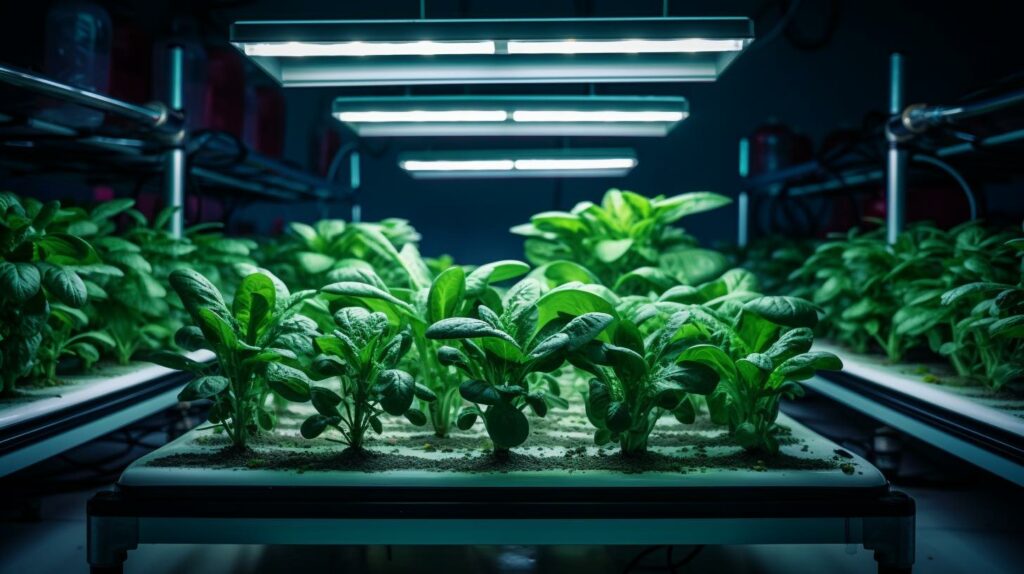
Adequate Temperature and Humidity
Maintaining the right temperature and humidity is essential for the successful vegetative stage in hydroponics. During this stage, plants are actively growing and developing, and optimal environmental conditions are necessary for their growth.
Here are three key factors to consider:
- Temperature control: Consistently maintaining a temperature range of 70-80°F (21-27°C) is important during the vegetative stage. This allows plants to efficiently carry out photosynthesis and absorb nutrients.
- Humidity levels: It’s ideal to keep humidity levels between 50-70% during the vegetative stage. This helps prevent excessive water loss through transpiration and reduces the risk of mold and fungal diseases.
- Ventilation: Proper airflow and ventilation play a crucial role in regulating temperature and humidity. Installing fans or using an exhaust system can help circulate fresh air, creating an optimal growing environment.
Proper Air Circulation
Proper air circulation is vital for successful plant growth in hydroponics. Ventilation is essential to provide fresh air, remove excess heat, and prevent the buildup of humidity and stagnant air.
It plays a critical role in promoting healthy growth by ensuring that plants receive an adequate supply of oxygen, carbon dioxide, and other essential gases. Without proper airflow, plants may suffer from oxygen deprivation and the accumulation of harmful gases, which can hinder their growth and overall health.
Ventilation Importance
Proper air circulation is a top priority during the vegetative stage of hydroponics. By using fans to promote healthy plant growth, I ensure that the plants have the optimal environment to thrive. Ventilation plays a crucial role in hydroponics for several reasons:
- Prevents heat buildup: Effective ventilation techniques help dissipate excess heat, preventing it from accumulating and causing damage to the plants. This becomes especially important in indoor hydroponic setups where maintaining the right temperature is essential.
- Reduces humidity: Maintaining proper air circulation helps keep the humidity levels in the grow area at an optimal range. Excessive humidity can lead to the growth of mold and fungal diseases, which can harm the plants. Ventilation is key in controlling humidity levels and preventing these issues.
- Enhances CO2 distribution: Good air circulation ensures the even distribution of carbon dioxide (CO2) throughout the grow area. CO2 is vital for photosynthesis, and proper ventilation helps ensure that plants receive an adequate supply. This, in turn, improves their overall growth and development.
Airflow for Growth
Ensuring optimal plant growth during the vegetative stage in hydroponics requires prioritizing proper airflow. Effective ventilation techniques play a crucial role in creating a healthy and productive hydroponic environment. By managing airflow, we can regulate temperature, remove excess moisture, and provide a consistent supply of fresh air for the plants.
To achieve this, I utilize various ventilation techniques such as exhaust fans, air circulation fans, and strategically positioned vents. Exhaust fans help expel stale air and moisture, while air circulation fans ensure that fresh air reaches every part of the plant canopy. Vents allow for the intake of fresh air, further enhancing the airflow within the grow space.
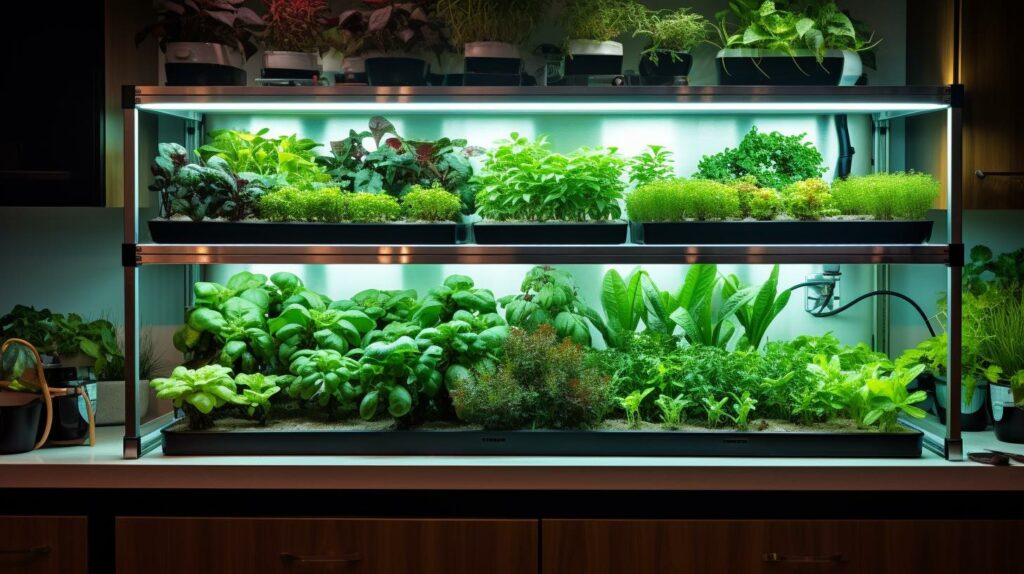
Ph Level Control
Maintaining the right pH levels is crucial for effectively controlling nutrient uptake during the vegetative stage in hydroponics. Monitoring pH levels is an essential practice that helps growers ensure their plants receive the optimal nutrient solution. Here are three important factors to consider when it comes to pH level control:
- Regular monitoring:
It’s important to regularly test the pH of the nutrient solution to identify any fluctuations or imbalances. This can be done using pH testing kits or meters, which provide accurate readings for adjustments.
- Nutrient solution adjustment:
Based on the pH readings, adjustments may be necessary to bring the pH levels within the desired range. pH up or pH down solutions can be added to raise or lower the pH accordingly.
- Maintaining consistency:
Consistency is key in pH level control. It’s important to consistently monitor and adjust the pH levels throughout the vegetative stage to ensure optimal nutrient uptake and healthy plant growth.
CO2 Supplementation
During the vegetative stage in hydroponics, it’s crucial to monitor and adjust pH levels for optimal nutrient uptake. One important factor to consider for enhanced plant growth is the supplementation of carbon dioxide (CO2). CO2 is essential for photosynthesis, the process by which plants convert light energy into chemical energy. By supplementing CO2 levels in the grow environment, we can speed up plant growth and maximize their potential.
During the vegetative stage, plants are actively growing and developing leaves, stems, and roots. Providing an adequate supply of CO2 promotes healthy and vigorous growth, resulting in larger and more productive plants. Additionally, increased CO2 levels improve nutrient uptake efficiency, allowing plants to absorb and utilize nutrients more effectively.
To enhance plant growth during the vegetative stage in your hydroponic system, consider incorporating CO2 supplementation. This will lead to a more abundant harvest and ensure that your plants reach their full potential.
Pruning and Training Techniques
Using pruning and training techniques during the vegetative stage in hydroponics is essential for shaping and optimizing the growth of plants. Pruning offers several benefits, including improving air circulation and light penetration, removing damaged or diseased foliage, and redirecting energy towards new growth.
To maximize the potential of plants, the following training techniques can be employed:
- Topping: This technique involves removing the top growth of the main stem to encourage lateral branching and create a bushier plant.
- LST (Low-Stress Training): By gently bending and tying down branches, a more even canopy can be created, increasing light exposure to lower parts of the plant.
- SCROG (Screen of Green): Placing a screen or net above the plants and training them to grow horizontally results in a more uniform and productive canopy.
Disease and Pest Prevention
To effectively prevent diseases and pests in hydroponics, I use a proactive approach that involves regular monitoring and implementing preventative measures. One of the key strategies I employ is crop rotation. By rotating the crops, I disrupt the life cycles of pests and diseases, reducing their impact on the plants. This also helps optimize nutrient uptake and minimize the risk of nutrient deficiencies.
Additionally, I use biological control methods to keep pests in check. This involves introducing beneficial insects or organisms that prey on pests, effectively controlling their population without the need for harmful chemicals.
Overall, this approach not only ensures a healthier and more productive crop, but also promotes sustainability and environmental stewardship in hydroponics.
Strategies for Disease and Pest Prevention:
- Regular monitoring: Regularly monitoring the plants allows for early detection of any signs of diseases or pests. By identifying and addressing issues promptly, I can prevent them from spreading and causing significant damage.
- Crop rotation: Crop rotation is another important measure in disease and pest prevention. By rotating the crops, I break the cycle of pests and diseases that may be specific to certain plant species. This interrupts their life cycle and reduces their impact on the plants.
- Biological control: Biological control involves the use of beneficial insects or organisms that act as natural predators to pests. These biological agents can effectively control pest populations without the need for harmful chemicals, promoting a more sustainable and eco-friendly approach to disease and pest prevention in hydroponics.
Frequently Asked Questions
What Is the Recommended Light Cycle Duration for the Vegetative Stage in Hydroponics?
The recommended light cycle duration for the vegetative stage in hydroponics is typically 18-24 hours of light per day. It is important to also change the nutrient solution every 1-2 weeks for optimal growth. During the vegetative stage, plants require longer periods of light to promote leaf and stem development. This extended light exposure stimulates photosynthesis and helps the plants grow vigorously. However, it’s essential to maintain a consistent light schedule and provide periods of darkness for the plants to rest and recover. Additionally, regular nutrient solution changes ensure that the plants receive the necessary nutrients for healthy growth. By following these guidelines, you can support robust vegetative growth in your hydroponic system.
How Often Should Nutrient Solution Be Changed During the Vegetative Stage?
During the vegetative stage, it is recommended to change the nutrient solution every two weeks. This ensures that the plants receive fresh and balanced nutrition, which is essential for their optimal growth. Additionally, maintaining a light cycle duration of 18 hours of light per day is ideal for promoting healthy vegetative growth.
Can I Use Tap Water for Hydroponics, or Do I Need to Use Filtered or Distilled Water?
Using filtered water is important for hydroponics because tap water can contain impurities that can harm the plants. By filtering the water, you can remove these impurities and ensure healthier growth and optimal nutrient absorption. This is crucial for the success of your hydroponic system.
Are There Any Specific Temperature and Humidity Ranges That Are Ideal for the Vegetative Stage?
Temperature and humidity play a crucial role in the vegetative stage of hydroponics. Along with other important factors like light cycle duration, nutrient solution change frequency, and a reliable water source, they contribute to the success of this stage. It may also be necessary to supplement CO2 levels. By maintaining the right temperature and humidity, providing adequate light, and ensuring proper nutrition and CO2 levels, growers can create an optimal environment for their plants to thrive during the vegetative stage.
Is It Necessary to Use a CO2 Supplementation System During the Vegetative Stage, or Can Plants Thrive Without It?
Using a CO2 supplementation system during the vegetative stage can greatly benefit plant growth. It provides an additional source of carbon dioxide that plants need for photosynthesis, which can lead to increased growth rates and healthier plants. However, it’s important to note that while CO2 supplementation can be beneficial, it is not absolutely necessary for plants to thrive. There are alternative methods, such as optimizing light levels and providing adequate nutrients, that can also support healthy plant growth. It’s essential to consider the specific needs of your plants and assess whether CO2 supplementation is necessary based on factors like the size of your growing space and the type of plants you are cultivating.

